Community Request Queue Management System for Local Government Unit of Cabanatuan City
Ashlee Jae J. Himo1, Alyssa Gail M. Medina2, Jeremie M. Santos3, Jerwin G. Servito4 , Rachel T. Alegado5
Nueva Ecija University of Science and Technology, Philippines 1ajhimo@gmail.com, 2alyssagailm@gmail.com, 3jeremie.santos88@gmail.com, 4servitojerwin@gmail.com, 5rachelalegado@gmail.com
Received Date: October 23, 2022
ABSTRACT
Accepted Date: November 25, 2022 Published Date: December 06, 2022
The Community Request Queue Management System for Local Government Unit of Cabanatuan City aimed to give solutions to the following struggles of Barangay officials: pen and paper storage management, complicated retrieval of records, and compromised set up due to the COVID-19 pandemic.
The system went through the stages of the Software Development Life Cycle, namely: Stage 1 – Requirement Analysis; Stage 2 – System Design; Stage 3 – Development; Stage 4 – Testing; Stage 5 – Deployment; and Stage 6Maintenance. The system took ten months to design and develop. Different softwares were used for the development of the user and admin interface using programming languages, which are HTML, Java, and PHP. For the developmentofthedatabase,MySQLwasutilized.It hasbeen strongly agreed by Barangay Officials and users based on the following criteria: functionality, usability, efficiency, portability, reliability, and security.
The system gave the barangay officials a modern, convenient, and efficient way of performing their services. It lessened the people coming in and out in the barangay hall, thus resulting in the adherence to the COVID-19 protocols.
The Community Request Queue Management System for Local Government Unit of Cabanatuan City provided the Sumacab Sur Citizens an alternative way of submitting inquiries, filing complaints and requesting documents. The Barangay Personnel were able to produce printed requested documents and give their response via e-mail.
Key words: Management System, Electronic Mail, Barangay, SDLC, Programming Language.
1. INTRODUCTION
A barangay is the smallest administrative division in the Philippines. Officials who are in charge of a certain barangay are tasked to handle processing and printing of different types of documents that can be requested and filed in the barangay. Certain documents can be used for applying
for a bank account, account validation, etc. As the population grows, more workload is added in order to sustain all the duties of the barangay office especially when citizens request for a certification when it is the registration and renewal season of different scholarships, and more. However, due to the pandemic, all barangay methods and rules were compromised for all citizens and barangay officials to ensure their safety. Due to this, the Barangay officials can only accommodate thirty up to fifty percent of their original accommodation.
In order to comply with the duties and responsibilities of barangay officials, there is a constant need to improve their services and resources. This system will help the Barangay Officials accommodate all submitted requests and queries of citizens without compromising their health and stillensuringutmost safetyfor barangayofficialsand citizens.
A study in Camarines Sur was conducted last April 2021 was conducted to aid the researchers in computing for the awareness, satisfaction, and availability of services as the needsarose.The overall Economic and Investment Promotion was low in satisfaction (56.35%) but high in need for action (90.48%) [1]. Service areas falling under Opportunities for Improvement are those targeted as critical areas for improvement because they scored relatively low in satisfaction but were deemed to highly require local government action. Moreover, these services were deemed to be critical points for serious quality improvements. The negative aspects of delivery of these services were presumed as drivers for dissatisfaction, but, if addressed, they can be potential drivers for satisfaction.
According to authors in [10], every Local Government Unit shall exercise using their powers to provide necessary and appropriate actions to produce an efficient and effective governance while being peaceful, socially protective, safe, and environmentally protective. Furthermore, these services are to be prioritized as it shapes the potent and central role of how local governments should develop communities. There are new challenges to be faced and new solutions to be produced to keep up with the actual needs of the citizens.
Ashlee Jae J. Himo et al., International Journal of Advanced Trends in Computer Science and Engineering, 11(6), November - December 2022, 285 - 293 285
ISSN 2278-3091
2. OBJECTIVES
This study aimed to develop a “Community Request Queue Management System”, and to evaluate its efficiency and effectiveness upon use. Specifically, this study addressed the following concerns:

1. Development and Description of the Community Request Queue Management System based on the following stages of the Waterfall Model:
1.1 Requirement Analysis;
1.2 System Design;
1.3 Development;
1.4 Testing;
1.5 Deployment; and
1.6 Maintenance.
2. Assessment of respondents on the developed Community Request Queue Management System based on the following criteria:
2.1. Functionality;
2.2. Usability;
2.3. Efficiency; 2.4. Portability;
2.5. Reliability; and
2.6. Maintainability.
3. METHODOLOGY
3.1 Research Design
ThedevelopersusedtheDevelopmentalMethodin this study. The use of observation and interview techniques were utilized as tools in gathering data.
The study implements the stages of the Waterfall Software Development Life Cycle (SDLC), e.g., Requirement Analysis, System Design, Development, Testing, Deployment, and Maintenance. These stages helped the researcher in developing the proposed system.
3.2
Analysis of Data
The data gathered in the assessment stage was analyzed using weighted mean.
4. RESULTS AND DISCUSSION
1. DesignandDevelopmentofCommunityRequestQueue Management System for Local Government Unit of Cabanatuan City
This project was developed using System Development Life Cycle (SDLC), which consists of six phases of development. The lay-out of the project and the scope of operation are discussed below:
Stage 1 – Requirement Analysis
This stage covered the period from January 17 to February 25, 2022, with the following activities were accomplished:
1.1 The developers began brainstorming to come up with the capstone titles and possible features of the system. Capstone titles were analyzed and created based on the community problems which will bring solutions upon deployment.
1.2 The developers presented different capstone titles with their IT CAP01 Professor to identify which capstone titles were feasible. Once identified, the developers can start the process of the system. The capstone title was finalized and entitled as “Design and Development of Community Request Queue Management System for Local Government Unit of Cabanatuan City.”.
1.3 The developers conducted an interview with one Barangay Official to list down the forms that Sumacab Sur citizens can request in the Barangay Hall.
1.4 The data given were carefully used and analyzed in order for the developers to come up with the proper content, user interface and features of the system.
1.5 Some related studies and researches were analyzed and compared with the existing contexts related to the study to possibly improve the components of the system.
1.6 Through several researches, additional ideas were added to finalize the outline of the system.
1.7 Set of components were done to verify and finalize the contents, user interface and features of the system based on the interviewed Barangay Official and developers. It helped the developers determine what the Sumacab Sur citizens will need for the system. System’s Gantt chart illustrates the six stages of the system project development with respect to time, i.e., from the third week of January2022 to the last week of August 2022. The Gantt Chart also included the duration of when the developers achieved the progress.
Stage 2 – SystemDesign
This stage was done fromFebruary26, 2022 to April 1, 2022. The following activities were accomplished:
2.1. The developers based the system design of the capstone system on the given data of the Barangay Officials who were interviewed.
2.2 The forms stated by the Barangay Official were all integrated into the system with additional basic information about the operation and rules of the Barangay Hall of Sumacab Sur. Figure 5 shows the system design of the Community Request Queue Management System for the
Ashlee Jae J. Himo et al., International Journal of Advanced Trends in Computer Science and Engineering, 11(6), November - December 2022, 285 - 293 286
Figure 1: Community Request Queue Management System for Local Government Unit of Cabanatuan City System’s Gantt Chart
Local Government Unit of Cabanatuan City. In this web page the user will be able to request, queue or inquire to the barangay by filling out the boxes. Each form may vary depending on which form was requested, inquired or queued.
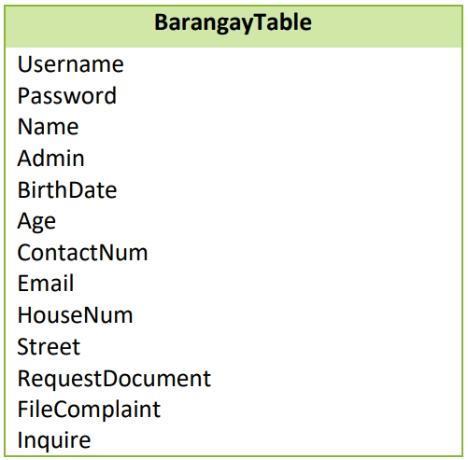
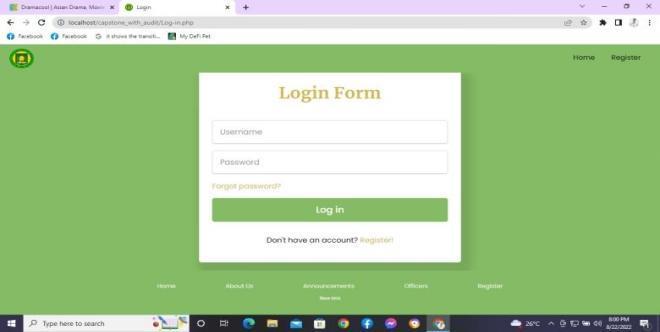
Figure 2: Hypertext Markup Language Integrated Development Environment
2.3 The database normalization was drawn to show how the database was normalized froman unnormalized table to its third normalization form. Figure 3 to 5 illustrates the database normalization for the developed Community Request Queue Management System for Local Government Unit of Cabanatuan City System.
Figure 5: Community Request Queue Management System for Local Government Unit of Cabanatuan City System Second Normalization Form
Figure 3: Community Request Queue Management System for Local Government Unit of Cabanatuan City System
Unnormalized Table
Figure 4: Community Request Queue Management System for Local Government Unit of Cabanatuan City System First Normalization Form
Figure 6: Community Request Queue Management System for Local Government Unit of Cabanatuan City System
Third Normalization Form
Figure 3 shows the unnormalized table of the database where possible entities were given to construct the system design of the database. Figure 4 shows its first normalization form. The entities and type of forms are
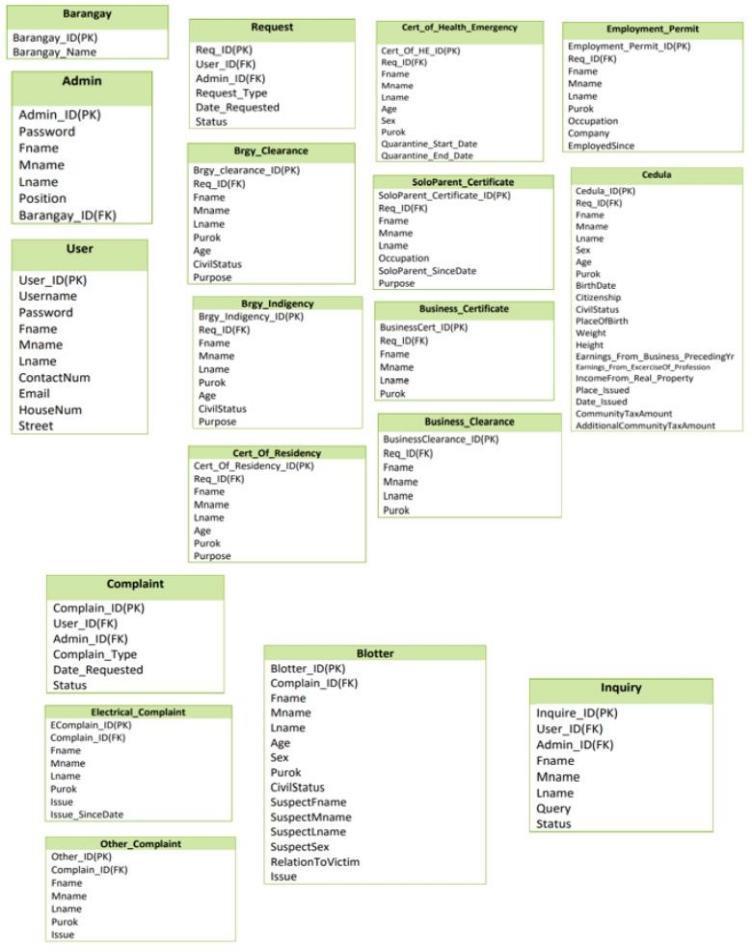
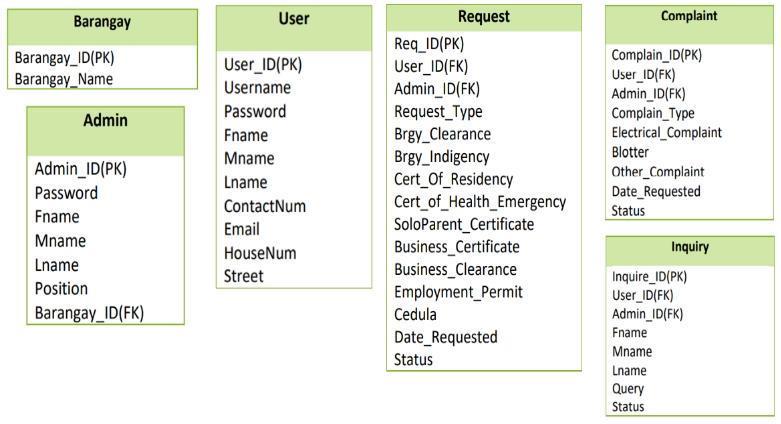
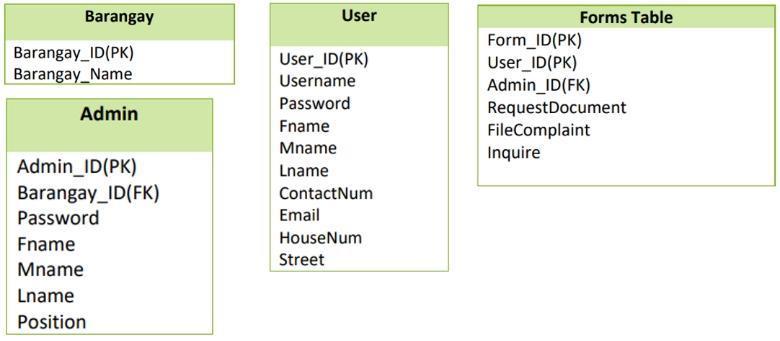
Ashlee Jae J. Himo et al., International Journal of Advanced Trends in Computer Science and Engineering, 11(6), November - December 2022, 285 - 293 287
identified and the data needed per entity was listed. Figure 5 still has dependencies that is why Figure 6 was created. From one table of forms, all types of forms were identified and grouped according to their designated entities and relationship. Figure 6 shows the third normalization form of the system and all entities of the system if finalized.
2.4 The use case diagram was drawn to show how the users can interact with the system and what its functionality is. It also showed the roles of each actor who may directly or indirectly use the system. Figure 7 illustrates the use case diagram for the developed Community Request Queue Management System for Local Government Unit of Cabanatuan City System.
able to inquire, request a document or file a complaint. After submitting a form, the user may log out.
The admin in charge shall process the submissions of the users. The admin shall log in first to view, process and give response to the submissions of the user. If necessary, the admin can reset their password if there seems to be an issue.
If the user requested a document, the admin should provide a printed copy of the document and send an email to the user to claim the requested document. If the user sent an inquiry or filed a complaint, the admin will give their response through email
2.5 The data flow diagram was made to show the flow of data within the system. This was the diagram used by the developers to visualize the flow of data as provided by different external entities.
Figure 7: Community Request Queue Management System for Local Government Unit of Cabanatuan City System Use Case Diagram
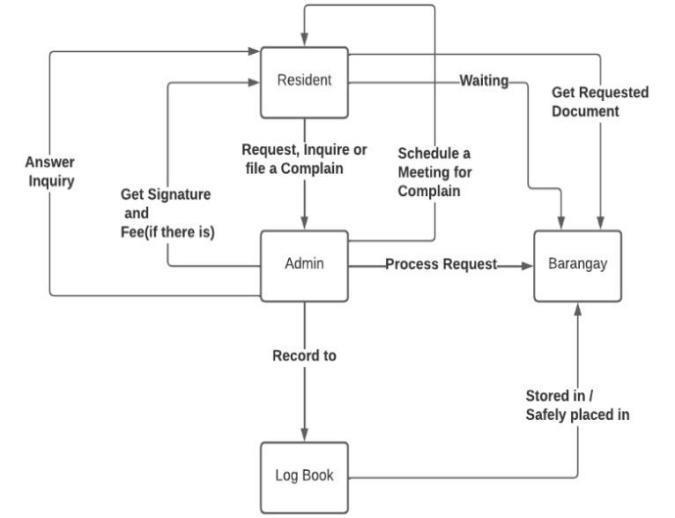
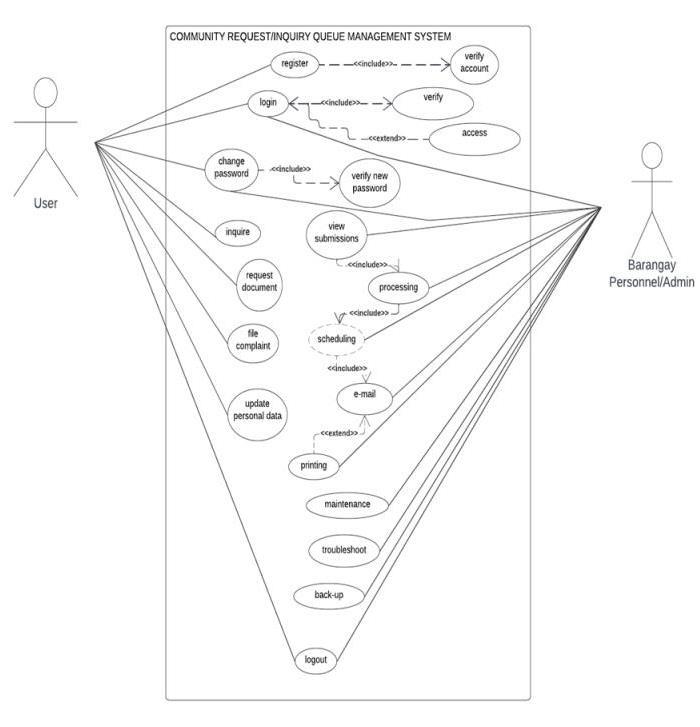
The user must register first to inquire, request a document or file a complaint. Through registration, the system will verify if a username and email exist to prevent having duplicated accounts. After it, the user may log in. However, ifthe user hasanofficial account, theymayproceed to log in first. By logging in, the system will verify their username and password. If it does not match, user access will not be granted. If necessary, the user can reset their password if there seems to be an issue. Once logged in, the user will be
Figure 8: Community Request Queue Management System for Local Government Unit of Cabanatuan City System Manual Data Flow Diagram

The manual requesting for documents, filing of complaints and filing of inquiries are done by going to the Barangay Hall. The residents will need to go to the barangay and ask the admin or secretary of the barangay to avail such services. The admin then will processthe request and print the document needed, complaint and schedule the time and date of the meeting or answer the inquiries then record it to the logbook of the barangay.
Figure 9: Community Request Queue Management System for Local Government Unit of Cabanatuan City System Level 0/Contextual Data Flow Diagram
Ashlee Jae J. Himo et al., International Journal of Advanced Trends in Computer Science and Engineering, 11(6), November - December 2022, 285 - 293 288
The user can request a document, file a complaint or send an inquiry to the Barangay. Users will receive an email about their inquiry and schedule about the availability of the document they requested or about the complaint they filed. The admin can view the user information, request data, complaint data and inquiry data. The admin can process and print the requested document of the user. The admin can send a schedule and response about the filed complaint. In inquiry, the admin can send answers about the questions of the user.
Figure 10: Community Request Queue Management System for Local Government Unit of Cabanatuan City System Level I Data Flow Diagram

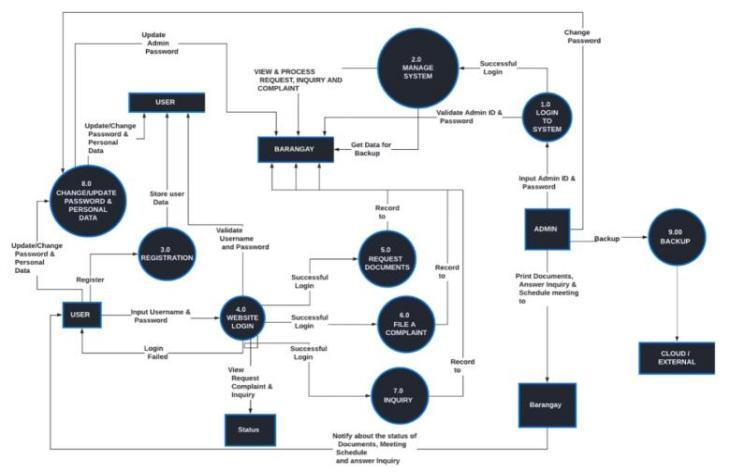

The user will register and fill out the required information. After it, the user will login upon finishing the registration. The system will verify the Username and Password of the registered user. If the user fails to login, they have a choice to forget and reset their password. However, if theusersuccessfullyloggedin,theusercanproceedtorequest a document, file a complaint, or send an Inquiry. The user can also view the status of their request, complaint or inquiry. The admin, who is authorized to view and edit the protected data or information about the user will have to login. The admin can view and process the requested documents, filed complaints and inquiry of the user. The data will also be backed up by the admin to the external or cloud storage.
Figure 11: Community Request Queue Management System for Local Government Unit of Cabanatuan City System Data Flow Diagram Level II
The user will register and fill out the required data. The user will log in upon finishing the registration. The system will verify the username and password of the registered user. If the user fails to login, they have an option to forget and reset their password or re-register. If the user successfully logged in, the user will be prompted to three choices which are: to inquire, request, or file a complaint. The system will save the user input for inquiry, request and complaint. The user has an option to view the status of their submitted form. To process the submissions, the admin will have to login to view and edit the protected data or information about the user. The admin will be responsible for answering inquiries, printing requested documents and processing the complaint of the user.
2.6 The entity-relationship diagram was drawn to show the overall concept of the system. Figure 12 illustrates the entity relationship diagram for the developed Community Request Queue Management System for the Local Government Unit of Cabanatuan City.
Ashlee Jae J. Himo et al., International Journal of Advanced Trends in Computer Science and Engineering, 11(6), November - December 2022, 285 - 293 289
Figure 12 shows the Entity Relationship Diagram used in the system. The figure emphasized the relations of each and every table. The Entity Relationship Diagram has different components included such as entities, attributes, relationship, cardinalities and key values. The figure also shows different types of cardinalities present such as one is to one, one is to many and many to many.
Stage 3 – Development
In stage 3, the developers have accomplished the system by 100% from April 2 to September 20, 2022. The software development consists of: website system that will serve as the user interface of the users, a java interface system that will be connected to the website which will be used by the barangay official or intended admin, and lastly, the database that will be used to store the data of the system.
Website System. The website system was developed with Hypertext Markup Language (HTML) integrated with Hypertext Preprocessor (PHP). The advantages of Hypertext Markup Language (HTML) are HTML is user-friendly, most friendly search engine, display

changes instantly, supported by all browsers, can integrate easily with other languages and more.
Java Interface System. The java interface system was developed using the Java Programming Language. The advantages of java are it is robust, secured, portable, distributed and more.

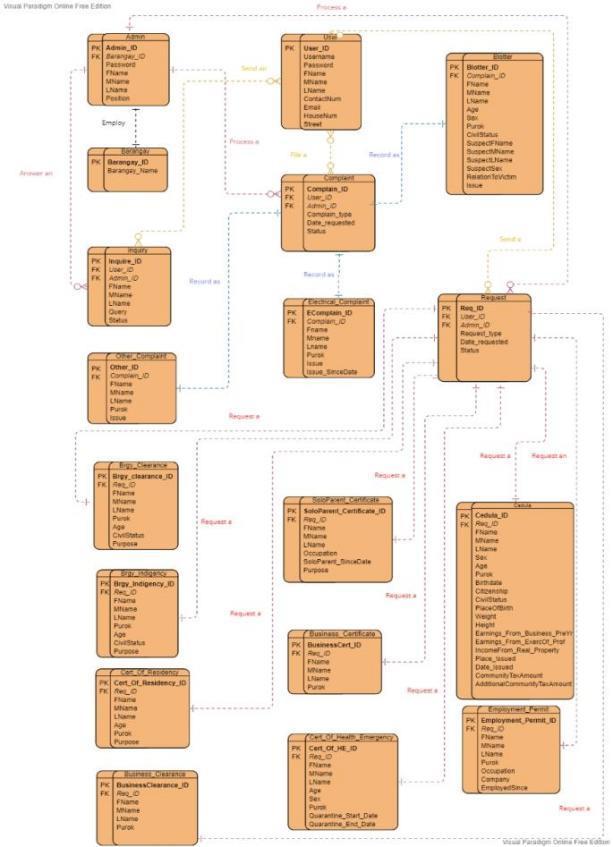
Figure 13 to 15 shows the snapshot of the interface of the system and the actual coding environment of the Community Request Queue Management System for Local Government Unit of Cabanatuan City where the system has been developed. Figure 13 shows the home webpage with certain source code, this is where the user can choose to log in or view the details of the Barangay Hall of Sumacab Sur.
Figure 14 shows the database connection of the website using PHP. Figure 15 shows the source code for the user interface intended for Barangay Officials or intended admin.
Ashlee Jae J. Himo et al., International Journal of Advanced Trends in Computer Science and Engineering, 11(6), November - December 2022, 285 - 293 290
Figure 12: Community Request Queue Management System for Local Government Unit of Cabanatuan City System Entity Relationship Diagram
Figure 13: Community Request Queue Management System for Local Government Unit of Cabanatuan City Coding Environment using Hypertext Markup Language (HTML)
Figure 14: Community Request Queue Management System for Local Government Unit of Cabanatuan City Coding Environment using Hypertext Preprocessor (PHP)
Figure 15: Community Request Queue Management System for
Local Government Unit of Cabanatuan City Coding Environment
using Java Programming Language

Database. This system used a Relational Database Management System. The database consists of tables that store records implemented in the MySQL Server database. By using a database, the users will be able to add, edit, delete and update their personal data or data to be input to certain forms. Structured Query Language (SQL) Server is fast and easy, it can store a very large record and requires little configuration.
Stage 4 – Testing
This stage was completed from September 21, 2022 to September 26, 2022. The objective of this stage was to evaluate the capability of a program or system and determine that it meets its required results. The developed Community Request Queue Management System for Local Government Unit of Cabanatuan City Management System was tested and evaluated based on the following criteria: functionality, usability, efficiency, portability, reliability and maintainability.
The system was tested in different operating systems such as Windows, Android, and iPhone. To ensure if the website is responsive, the user interface was tested using laptop, personal computer and mobile phones. Each interface of the developed system was checked, making sure that all hyperlinks, buttons and back-end processes are complete and accurate. The transactions and processes of the system should perform according to the requirements and should come up with the desired output. The developers tested the responsivenessofthe website toensurethe stylesheetdoesnot overlap. In addition, the Java Interface was tested to ensure thatsubmittedformswereallcollectedandcanprintthe forms accordingly. Also, during the testing phase some of the codes were already corrected.
Stage 5 – Deployment
The website was deployed from September 21, 2022 to September 26, 2022. The developers did the following activities:
5.1Inthedeploymentstage, theCommunityRequest Queue Management System for Local Government Unit of Cabanatuan City was completed, checked and validated.
5.2 The developers looked for errors that may have been missed from the testing stage.
5.3 After the deployment, the system was tested by Sumacab Sur citizens and Barangay Officials in charge of handling data digitally.
Stage 6 – Maintenance
The last stage was conducted for six days starting from September 21, 2022 to September 26, 2022. The developers did the following activities:
6.1 Errors that became visible in the actual deployment were corrected.
6.2 Few minor changes were considered to not compromise the confidentiality of user’s sensitive data.
6.3 The system was updated and enhanced to satisfy the needs of the users.
6.4 The developers found out that some testers could not access the website properly due to IP Address complications.
6.5 The developers came up with a solution to solve the IP Address complications in Windows Operating System, Android Operating System and iPhone Operating System.
2. Assessment of the Respondents on the Developed Community Request Queue Management System for
Local Government Unit of Cabanatuan City
The assessment conducted was based on the Request Queue Management System characteristics, namely: functionality, usability, efficiency, portability, reliability, and maintainability.
2.1 The overall weighted mean of functionality was 4.28, described as Excellent.
2.2 The overall weighted mean of usability was 4.30, described as Excellent.
2.3 The overall weighted mean of efficiency was 4.36, described as Excellent.
2.4 The overall weighted mean of portability was 4.40, described as Excellent.
2.5 The overall weighted mean of reliability was 4.30, described as Excellent.
2.6 The overall weighted mean of maintainability was 4.35, described as Excellent.
3. Assessment of the Request Queue Management System’s quality of use by end-users:
3.1 The Sumacab Sur Citizen assessment recorded an overall weighted mean of 4.84.
3.2 The overall weighted mean on barangay personnel’s assessment was 4.75.
Ashlee Jae J. Himo et al., International Journal of Advanced Trends in Computer Science and Engineering, 11(6), November - December 2022, 285 - 293 291
5. CONCLUSIONS
The following are the conclusions drawn from the findings of the study.
1. The design and development of the Community Request Queue Management System for Local Government Unit of Cabanatuan City went through the stages of the Software Development Life Cycle as follows: Stage 1 –Requirement Analysis; Stage 2 – System Design; Stage 3 –Development;Stage4 –Testing;Stage5 –Deployment;Stage 6- Maintenance.
2. The system took ten months to design and develop. Different softwares was used such as Visual Studio Code for the development of the website using programming languages: HyperText Markup Language and Php. Apache Netbeans, for the development of the Administrator interface using Java Programming Language. Xampp, for the creation ofthe Database usingMySQL. Ngrok, forrunningthe website for testing and execution.
3. The suggestions given by the barangay officials and respondents may be considered for future improvement and development of the system.
4. The design and development of the Community Request Queue Management System for Local Government Unit of Cabanatuan City gave the barangay hall and its officials a modern, convenient and efficient way of performing their services
5. The design and development of the Community Request Queue Management System for Local Government Unit of Cabanatuan City lessened the population of people coming in and out in the barangay hall. Thus, resulting following the COVID-19 safety protocols.
6. The design and development of the Community Request Queue Management System for Local Government Unit of Cabanatuan City provided the Sumacab Sur Citizens an alternative way of submitting inquiries, filing complaints and requesting documents.
6. RECOMMENDATIONS
Based on the findings drawn, the following recommendations were presented:
1. A full implementation of the design and development of the Community Request Queue Management System must be done for every barangay hall within the Cabanatuan City to exercise a more efficient, convenient and modern way of providing services.
2. To include photos of the assigned barangay official that is handling a specific inquiry, document and complaint form for the Sumacab Sur Citizen to easily identifythe assigned barangay official for retrieval purposes only.
3. To improve the network latency of the website for faster loading.
4. To provide a better website host domain to avoid network problem connections.
ACKNOWLEDGEMENT
This system became a reality with the help and guidance of many individuals that supported the database developers. The developers would like to express their deepest gratitude to those who made the system possible.
Firstand foremost, the student developers would like to offer this endeavor to our God Almighty for bestowing wisdom amongst us, the strength and perseverance to continue with the progress and to achieve the same goals.
To the parents, for giving both financial and moral support throughout the entire journey of making the system possible.
To our beloved capstone adviser, Dr. Rachel T. Alegado for the never-ending advice and guidance from the beginning of the cycle until the end. The developers truly appreciate the effort of helping them complete the capstone.
To the cooperative barangay officials of the Sumacab Sur, for sharing the needed requirements and for providing all necessary information for the system to be built.
To the great Nueva Ecija University of Science and Technology, for giving the developers an opportunity to enhance and improve their technological, social and communication skills that were also used to complete this endeavor.
REFERENCES
[1] Bacares, N. E. (2021, April 30). Citizens’ Satisfaction on Economic and Investment Promotion Services of a Coastal Town in Camarines Sur, Philippines. Retrieved October 20, 2022, from Ssrn.com website: https://papers.ssrn.com/sol3/papers.cfm?abstract_id=383755 4
[2] Abdul Halim, S., Othman, M. H., Buja, A. G., Abdul Rahid, N. N., Sharip, A. A., & Md Zain, S. M. (2021). C19SmartQ: Applying Real-Time Multi-Organization Queuing Management System Using Predictive Model to Maintain Social Distancing International Journal of Interactive Mobile Technologies (IJIM), 15(06), 108. https://doi.org/10.3991/ijim.v15i06.20597
[3] International Journal of Mathematics & Computing. Research Article. BarangayManagementSystem. Received February 10, 2017; Accepted March 17, 2017; Published March 31, 2017; - PDF Free Download. (2017). Retrieved October 20, 2022, from Docplayer.net website: https://docplayer.net/140683583-International-journal-ofmathematics-computing-research-article-received-february10-2017-accepted-march-17-2017-published-march-312017.html
[4] Asghar, R. (2014, June 13). The Art of The Effective Business Email. Forbes. Retrieved from https://www.forbes.com/sites/robasghar/2014/06/12/the-artof-the-effective-business-email/?sh=497744ce7875
[5] https://www.facebook.com/lifewire. (2021). What Is Email aka Electronic Mail? Retrieved October 20, 2022,
Ashlee Jae J. Himo et al., International Journal of Advanced Trends in Computer Science and Engineering, 11(6), November - December 2022, 285 - 293 292
from Lifewire website: https://www.lifewire.com/electronicmail-overview-1164107
[6] Paldez, A. J., Pintucan, R. R., Sere, E. S., & Agustin, L. (2018, November). Web-Based Management System with SMS and E-mail Notification for Binan Tricycle Franchising and Regulatory... Retrieved October 20, 2022, from ResearchGate website: https://www.researchgate.net/publication/337707585_WebBased_Management_System_with_SMS_and_Email_Notification_for_Binan_Tricycle_Franchising_and_Re gulatory_Board
[7] Alam, Md. G. R., Suma, T. M., Uddin, S. M., Siam, Md. B. A. K., Mahbub, Md. S. B., Hassan, M. M., & Fortino, G. (2021). Queueing Theory Based Vehicular Traffic Management System Through Jackson Network Model and Optimization. IEEE Access, 9, 136018–136031. https://doi.org/10.1109/access.2021.3116503
[8] Abusair, M., Sharaf, M., Hamad, T., Dahman, R., & AbuOdeh, S. (2021). AnApproachforQueueManagement Systems of Non-Critical Services 20217thInternational Conference on Information Management (ICIM). https://doi.org/10.1109/icim52229.2021.9417043
[9] QueueManagementSystemMarket – GlobalIndustry Analysis By Deployment (Cloud-Based and On-Premises), by Type (Virtual Queuing and Linear Queuing), and by Application (Hospitals & Clinics, Banks & Financial Institutions, Retail Outlets, Private Utility Service Providers/Airline Check-In Counters, Self-Service Restaurants, Government Offices, Telecom Service Centers, and Others): Global Industry Perspective, Comprehensive Analysis, and Forecast, 2018–2025. (2018). Retrieved October 20, 2022, from Zionmarketresearch.com website: https://www.zionmarketresearch.com/report/queuemanagement-system-market
[10] Roy, B., & Venugopal, A. (2013, May 5). A NOVEL INTELLIGENT SYSTEM FOR EFFICIENT QUEUE MANAGEMENT. Retrieved October 20, 2022, from www.ijareeie.com website: https://www.ijareeie.com/upload/may/11_A%20NOVEL.pdf
[11] Vo, G. N., & Lai, R. (2014). A method for simplifying the submission of an online request for an E-Government service 2014 International Symposium on Technology Management and Emerging Technologies. https://doi.org/10.1109/istmet.2014.6936538
[12] Sumacab South (Barangay, Cabanatuan City, Philippines) - Population Statistics, Charts, Map and Location. (2020). Retrieved October 20, 2022, from Citypopulation.de website: https://www.citypopulation.de/en/philippines/cabanatuan/03 4903095__sumacab_south/
Jae J. Himo et al., International
- December 2022, 285 - 293 293
Ashlee
Journal of Advanced Trends in Computer Science and Engineering, 11(6), November

















